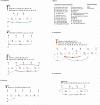A review of mechanistic models of viral dynamics in bat reservoirs for zoonotic disease
- PMID: 33185145
- PMCID: PMC7759253
- DOI: 10.1080/20477724.2020.1833161
A review of mechanistic models of viral dynamics in bat reservoirs for zoonotic disease
Abstract
The emergence of SARS-CoV-2, a coronavirus with suspected bat origins, highlights a critical need for heightened understanding of the mechanisms by which bats maintain potentially zoonotic viruses at the population level and transmit these pathogens across species. We review mechanistic models, which test hypotheses of the transmission dynamics that underpin viral maintenance in bat systems. A search of the literature identified only twenty-five mechanistic models of bat-virus systems published to date, derived from twenty-three original studies. Most models focused on rabies and related lyssaviruses (eleven), followed by Ebola-like filoviruses (seven), Hendra and Nipah-like henipaviruses (five), and coronaviruses (two). The vast majority of studies has modelled bat virus transmission dynamics at the population level, though a few nested within-host models of viral pathogenesis in population-level frameworks, and one study focused on purely within-host dynamics. Population-level studies described bat virus systems from every continent but Antarctica, though most were concentrated in North America and Africa; indeed, only one simulation model with no associated data was derived from an Asian bat-virus system. In fact, of the twenty-five models identified, only ten population-level models were fitted to data - emphasizing an overall dearth of empirically derived epidemiological inference in bat virus systems. Within the data fitted subset, the vast majority of models were fitted to serological data only, highlighting extensive uncertainty in our understanding of the transmission status of a wild bat. Here, we discuss similarities and differences in the approach and findings of previously published bat virus models and make recommendations for improvement in future work.
Keywords: Bat virus; SIR model; mechanistic model; virus dynamics; zoonotic disease.
Conflict of interest statement
The authors declare no conflict of interest.
Figures
Similar articles
-
Accelerated viral dynamics in bat cell lines, with implications for zoonotic emergence.Elife. 2020 Feb 3;9:e48401. doi: 10.7554/eLife.48401. Elife. 2020. PMID: 32011232 Free PMC article.
-
A tale of endurance: bats, viruses and immune dynamics.Future Microbiol. 2024 Jun 12;19(9):841-856. doi: 10.2217/fmb-2023-0233. Epub 2024 Apr 22. Future Microbiol. 2024. PMID: 38648093 Free PMC article. Review.
-
[Bats and Viruses: complex relationships].Bull Soc Pathol Exot. 2015 Oct;108(4):272-89. doi: 10.1007/s13149-015-0448-z. Epub 2015 Sep 1. Bull Soc Pathol Exot. 2015. PMID: 26330152 Free PMC article. Review.
-
Can Bats Serve as Reservoirs for Arboviruses?Viruses. 2019 Mar 3;11(3):215. doi: 10.3390/v11030215. Viruses. 2019. PMID: 30832426 Free PMC article. Review.
-
Review of bats and SARS.Emerg Infect Dis. 2006 Dec;12(12):1834-40. doi: 10.3201/eid1212.060401. Emerg Infect Dis. 2006. PMID: 17326933 Free PMC article. Review.
Cited by
-
Genomic representation predicts an asymptotic host adaptation of bat coronaviruses using deep learning.Front Microbiol. 2023 May 5;14:1157608. doi: 10.3389/fmicb.2023.1157608. eCollection 2023. Front Microbiol. 2023. PMID: 37213516 Free PMC article.
-
Detection and genetic characterization of circoviruses in more than 80 bat species from eight countries on four continents.Vet Res Commun. 2023 Sep;47(3):1561-1573. doi: 10.1007/s11259-023-10111-3. Epub 2023 Mar 31. Vet Res Commun. 2023. PMID: 37002455 Free PMC article.
-
Viral Co-Infection in Bats: A Systematic Review.Viruses. 2023 Aug 31;15(9):1860. doi: 10.3390/v15091860. Viruses. 2023. PMID: 37766267 Free PMC article.
-
Applications of VirScan to broad serological profiling of bat reservoirs for emerging zoonoses.Front Public Health. 2023 Sep 22;11:1212018. doi: 10.3389/fpubh.2023.1212018. eCollection 2023. Front Public Health. 2023. PMID: 37808979 Free PMC article.
-
Advances in understanding bat infection dynamics across biological scales.Proc Biol Sci. 2024 Mar 13;291(2018):20232823. doi: 10.1098/rspb.2023.2823. Epub 2024 Mar 6. Proc Biol Sci. 2024. PMID: 38444339 Free PMC article. Review.
References
-
- WHO . Coronavirus disease (COVID-2019) situation reports. 2020. [cited 2020 Jun 30]. Available from: https://www.who.int/emergencies/diseases/novel-coronavirus-2019/situatio...
Publication types
MeSH terms
Grants and funding
LinkOut - more resources
Full Text Sources
Other Literature Sources
Medical
Miscellaneous



